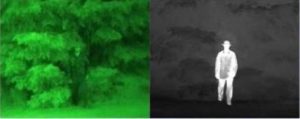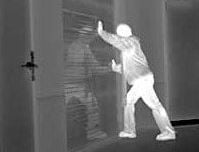Introduction
While he may be best known as the father of modern television, because of his invention of the “Rasioskop” three years earlier, in 1929, physicist Kalman Tihanyi made another significant impact on the world when he invented the world’s first night vision camera [1]. Night vision technology was immediately recognized for its military applications by the British for anti-aircraft defense, and very soon after the German company Allgemeine Elektrizitäts-Gesellschaft AG (AEG) began developing night vision systems which would later be used by the German army in World War II. While the original night vision imaging systems were revolutionary for their time, they suffered from many limitations ranging from sensitivity to resolution. Over the past 90 years, night vision technology has developed into a mature and diverse industry, fueled in large part by modern semiconductor technology.
These days night vision systems are utilized in a wide range of military and commercial applications, ranging from traditional night vision goggles to time-gated active surveillance. This article will start by reviewing the fundamentals of modern night vision camera technology. Next it will go on to discuss the differences between active and passive imaging systems. Finally, a detailed exploration of the advantages and disadvantages of laser-based active imaging systems will be presented, illuminating why, in some instances, lasers are the preferred illumination source despite their inherent drawbacks.
Night Vision Camera Fundamentals
Today’s modern night vision devices come in a wide variety of forms, making use of several different base technologies. This should not come as a surprise considering how broadly the category is defined by the United States Department of Homeland Security (DHS) as “A night vision device (NVD) is an electro-optical device that enhances vision in environmental conditions with little or no light.” In the same 2013 document on night vision technology, DHS goes on to discuss four main categories of NVDs: image intensifiers, thermal imaging cameras, integrated night vision systems, and infrared (IR) illuminators [2].
Image intensifiers are the oldest form of the technology which utilizes an array of photomultiplier tubes (PMTs) to amplify visible and near-infrared photons, which are being passively generated in the environment at very low light levels. In these systems the PMT array is typically placed in front of a compact phosphor screen, which will then glow (generally green or white) generating a visible monochromatic image. While these devices have the obvious drawbacks associated with PMTs, the fact that they are relatively inexpensive and low power analog devices makes them ideal for field-deployable night vision goggles and rifle scopes. The major downside of this technology is that the PMT has no way of differentiating between the different wavelengths and are not sensitive to mid- and far-infrared light. As a result, while they do an excellent job of producing an intensified image, they are not able to differentiate between object's heat signatures.
Thermal imaging cameras, on the other hand, utilizes a different technology that allows for detection of much longer wavelength photons typically in the mid- to far-infrared, which better correspond the blackbody (thermal) emission wavelengths of humans and powered technology. As a result, thermal imaging cameras are capable of identifying objects of interest and differentiating them from the colder background. For example, if a sniper is hiding in a tree at night their heat signature will be starkly different from that of the foliage. A similar case is shown in figure 1 below. The only downside to this technology is that unlike CCD cameras, which are extremely low noise and require very little power to operate, most infrared cameras are extremely noisy at room temperature. This requires them to be actively cooled, resulting in a much larger degree of power consumption and limits their usage in infantry applications where weight and power consumption are often an issue.

Figure 1: Comparison of a night vision image taken using an image intensive (left), and a thermal
image was taken with a thermal imaging camera. [3]
For the sake of brevity, integrated night vision systems, which are broadly defined as any system which integrates more than one technology, will not be discussed in the article. Instead, the remainder of this article will focus on IR illuminators, which form the foundation of active night vision imaging. An IR illuminator is defined as any night vision system which utilizes an infrared light source to illuminate an object of interest, instead of relying on the light passively generated by the environment. Ironically, the very first generation night vision goggles developed for the United States military in the 1940s were based on this principle, but at the time, infrared light sources were still in their infancy. As a result, they were quickly phased out in favor of passive night vision goggles.
Active Night Vision Imaging
Active night vision systems can come in many different forms, depending on the goal of the particular application. While broadband emission sources are still used in some active night vision systems, the vast majority of systems utilize either superluminescent diodes (SLDs) or lasers. Both of these sources offer highly effective light generation and can be tailored to specific wavelengths of interest, depending on the needs of the system. Additionally, both lasers and SLDs are capable of producing extremely bright beams, which can easily flood an extensive area with infrared light. The significant advantage of SLDs over laser sources is the fact that they are not coherence devices. This may sound counter-intuitive, but the extremely high coherence of lasers causes spatial interference when they reflect off a diffuse surface. This process, which is known as speckle, results in bright and dark spots in the image, degrading the overall image fidelity. Figure 2 below shows an example of an infrared image generated using a q-switched laser as the IR illuminator and a time gated InGaAs IR camera.

To continue please fill out the form below



 SHIPS TODAY
SHIPS TODAY 